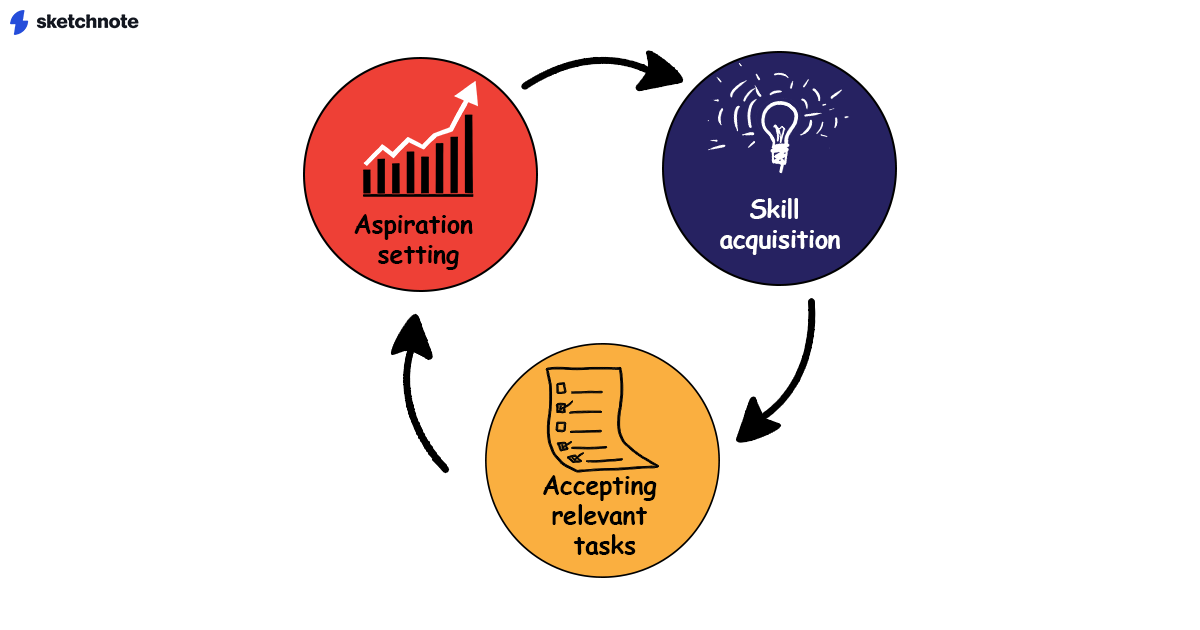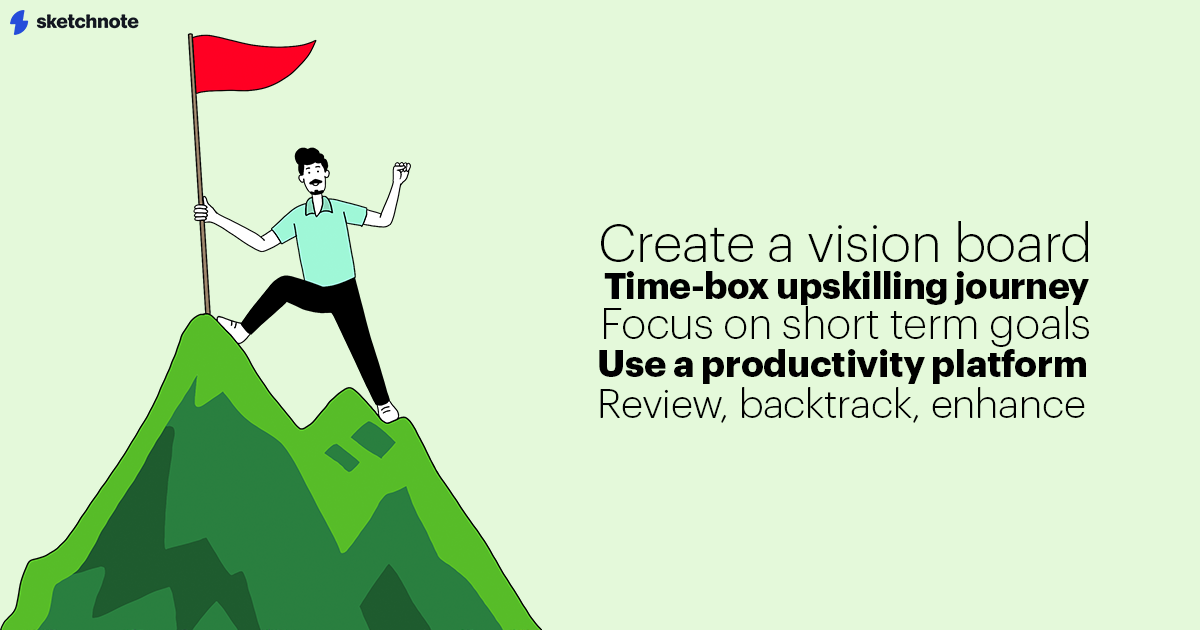The idea of "new year, new me" is a rather popular concept these days where one creates a benchmark for all the things they wish to achieve in the next calendar year. But, why should this just be limited to grooming your personal self? Instead, a holistic approach is required, with some room left for addressing your professional developmental goals too.
While the prospect of creating an action plan for these goals may seem daunting at the outset, it is vital to remember that a realistic and manageable plan is all that is required for you to start making a difference in your career.
This can involve:
- Acquiring new skills and knowledge relevant to your current role
- Taking on tasks and projects that align with your desired career path, and
- Setting aspirations to ascend the leadership ranks.
If this already seems like a tall task, and you're dreading the reality of what goal setting really involves... we've got you covered!
But if you've already experimented with goal setting, you probably know that your biggest apprehension with this activity usually revolves around a scenario where you hit a dead end after starting off well. You set a goal, make a plan, start cruising for a bit, and then suddenly bam! Things come to a standstill and you're back to square one.
Sound familiar?
Let us let you in on a secret. The key to avoiding being stuck in a rut is is setting S.M.A.R.T goals—that is, Specific, Measurable, Attainable, Realistic, and Time-Bound—and being consistent in implementing them!
And to effectively keep working towards your goals, it's essential to take conscious steps towards making them come true.
But first…

Why do you need a professional development goal at all?
Simply put, not having professional development goals leads to stagnation.
Establishing development goals can help you avoid becoming complacent and stay relevant to the ever-changing advancements in your career path.
These goals push you to take on new challenges, more responsibilities, and new projects that’ll lead to higher success. All of this while also keeping you motivated and preparing you better for any upcoming challenges at the workplace.
Now that you know the importance of keeping up, here’s a step-by-step action plan laid out for you.
5 Steps To Professional Goal Setting
Step 1: Create a digital vision board
Creating a vision board is a powerful tool for manifesting, setting, and achieving professional and personal goals. It's a visual representation of your goals and dreams, and it serves as a constant reminder of what you are working towards. And yes, you can use it for both your personal goals and your professional ones!
When you create a vision board, think about what you truly want to achieve in your professional life. This process of reflection helps you focus on the most important aspects of your career. When you feel stuck or unmotivated, looking at your vision board can remind you of why you set off on this journey and help you stay focused on your goals.
Additionally, when you achieve a goal that you have on your vision board, it can be incredibly fulfilling and motivating to physically cross it off or remove the goal.
So, take some time to sit down and create a vision board for your professional development goals. It could be a physical one or a digital one, but the key is to make it easily accessible to you and keep updating it as you progress.
Feeling pumped already? Start making your own vision board now by customizing a Sketchnote template whiteboard!
Step 2: Time box your upskilling journey
The field of technology is constantly evolving and new tools and techniques are being developed all the time! The best part is that you can leverage this advancement in technology to upskill yourself at any time. When you take an online course related to your job and role, it helps you stay up-to-date with the latest industry trends, while improving your knowledge and skills.
For example, if you're a designer, learning to develop a no-code website can help you stay updated with the latest web development trends and improve your skills in the field of website design. Similarly, if you're a branding expert, learning social media marketing can help match steps with the latest marketing trends and improve your skills in content creation and marketing.
One of the biggest challenges while taking an online course is being able to stay motivated constantly and committed to completing it. With so many distractions and competing demands for your time, it's easy to lose focus and leave the course midway. To ensure that you don't fall into this trap, it's crucial to set aside dedicated time for upskilling.
When you earmark 30-60 minutes of your day, specifically for learning, you can create a consistent routine that will help you stay focused.
Sketchnote offers a wide range of dedicated learning lessons on topics such as startups, design, technology, product development, and productivity, which can be completed over the weekends—or stretched across weekdays—allowing you to learn and make the most of your upskilling journey.

Step 3: Choose to focus on short-term goals instead of long-term professional goals
Shorter-term goals are generally considered to be more attainable because of their realistic and tangible nature. They offer a clear view of the progress made, goals in sight, and keep motivation high.
For example, a long-term goal might be, "I want to become a manager in five years." A short-term goal, on the other hand, can be, "I will take on additional responsibilities and volunteer for leadership opportunities within the next six months." Both these goals work towards the eventual goal of assuming a larger leadership role eventually, but building your responsibilities over the next six years instead of the vague idea of being on the top of the pyramid in five years, is more doable.
Furthermore, when working towards a goal, it's vital to have a laser-focused approach. Setting shorter-term goals allows for more precise energy allocation towards specific objectives, making it easier to accomplish them quickly, rather than getting sidetracked by the magnitude of long-term vision.
Step 4: Use a productivity platform
A productivity platform like Sketchnote can be highly beneficial in helping you stay on track and make the most of your time. The Analytics section of Sketchnote allows you to effortlessly track and measure your time spent on different work activities, giving you a clear overview of your progress.
Additionally, Sketchnote allows you to switch between work and learn mode, providing you with the chance to pursue work and learning on the same platform, yet on different dashboards. This can help you better balance these two aspects of your life and achieve your goals more efficiently.
Step 5: Review, backtrack and enhance
Regularly reviewing and adjusting your plan as needed is really vital here. When you reflect on how far you've come, it helps you realize if a strategy is not effective, course correct your action plan, and explore alternative methods with a greater likelihood of success.
Review your past actions and future plans on a pre-determined, regular basis to help you stay on track better.
Are you ready yet?
The favorite C word of any professional looking for growth should be consistency. Staying consistent is a big deal because small—but regular efforts—are way more effective than trying to make big changes all at once, and ultimately giving them all up.
Remember, professional growth is a continuous process, and by regularly revisiting, adjusting, and enhancing your plan, you will reach your desired outcome. Good luck!



